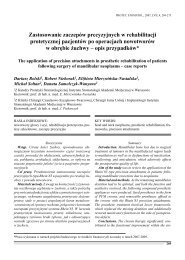peÅna wersja do pobrania - Protetyka Stomatologiczna
peÅna wersja do pobrania - Protetyka Stomatologiczna
peÅna wersja do pobrania - Protetyka Stomatologiczna
You also want an ePaper? Increase the reach of your titles
YUMPU automatically turns print PDFs into web optimized ePapers that Google loves.
Dysfunkcje u.r.n.ż.<br />
ustalenia stabilnego, centralnego położenia żuchwy,<br />
prawidłowego ułożenia wyrostków kłykciowych<br />
w <strong>do</strong>łach stawowych, warunkującego<br />
równowagę napięcia mięśni narządu żucia. W<br />
trakcie leczenia należy dążyć <strong>do</strong> maksymalnego<br />
zaguzkowania zębów w tej pozycji, by<br />
uniknąć późniejszych zaburzeń czynnościowych<br />
(45, 18).<br />
U pacjentów z zaburzeniami skroniowo-żuchwowymi,<br />
leczenie orto<strong>do</strong>ntyczne można rozpocząć<br />
po wyciszeniu <strong>do</strong>legliwości bólowych.<br />
Plan leczenia powinien być ustalany indywidualnie<br />
dla przypadku, uwzględniając wszystkie<br />
czynniki, z powodu których pacjent wymaga<br />
leczenia. Pacjenci z ogólnym bólem mięśniowo-szkieletowym,<br />
np. z fibromialgią lub z<br />
ogólną chorobą zapalną, jak na przykład reumatoidalne<br />
zapalenie stawów, powinni być leczeni<br />
interdyscyplinarnie (20).<br />
Pomimo braku <strong>do</strong>wodów naukowych, trudno<br />
wykluczyć udział leczenia orto<strong>do</strong>ntycznego<br />
w terapii TMD. Z obserwacji klinicznych<br />
wynika, że leczenie orto<strong>do</strong>ntyczne może<br />
istotnie pomóc w opanowaniu <strong>do</strong>legliwości<br />
ze strony stawu skroniowo– żuchwowego.<br />
Zadaniem leczenia orto<strong>do</strong>ntycznego jest bowiem<br />
nie tylko korekta wady zgryzu ale także<br />
przywrócenie harmonii zwarcia, symetrii pracy<br />
mięśni żucia i czynności stawów skroniowo-żuchwowych.<br />
Piśmiennictwo<br />
1. de Leeuw R.: Orofacial pain; guidelines for<br />
assessment, diagnosis, and management.<br />
Quintessence Pub. Co., 2008, 129-204.<br />
2. Okeson J. P.: Orofacial pain. Guidelines<br />
for assessment, diagnoses and managment.<br />
Chicago: Quintessence Pub. Co., 1996.<br />
3. Costen J. B.: A syndrome of ear and sinus<br />
symptoms dependent upon disturbed function<br />
of the temporomandibular joint. Ann. Otol.<br />
Rhinol. Laryngol., 1934, 43, 1-15.<br />
4. Ramfjord S. P.: Bruxism, a clinical and electromyographic<br />
study. J. Am. Dent. Assoc.,<br />
1961, 62, 21-44.<br />
5. Dawson P. E.: Evaluation, diagnosis and treatment<br />
of occlusal problems. ed. 2. St. Louis:<br />
Mosby-Year Book, 1989, 1-29, 434-456.<br />
6. Thompson J. R.: Abnormal function of the stomatognathic<br />
system and its ortho<strong>do</strong>ntic implications.<br />
Am. J. Orthod., 1962, 48, 758-765.<br />
7. McNamara J. A., Seligman D. A., Okeson J.<br />
P.: Ortho<strong>do</strong>ntic treatment and temporomandibular<br />
disorders: a review. J. Orof. Pain., 1995,<br />
9, 1, 73-90.<br />
8. Henrikson T., Ekberg E. C., Nilner M.:<br />
Symptoms and signs of temporomandibular<br />
disorders in girls with normal occlusion and<br />
Class II malocclusion. Acta. O<strong>do</strong>nt. Scand.,<br />
1997, 55, 4, 229-235.<br />
9. Lambourne C., Lampasso J., Buchanan W.<br />
C. Jr., Dunford R., McCall W.: Malocclusion<br />
as a risk factor in the etiology of headaches<br />
in children and a<strong>do</strong>lescents. Am. J. Orthod.<br />
Dentofacial. Orthop., 2007, 32: 754-761.<br />
10. Sonnesen L., Bakke M., Solow B.: Malocclusion<br />
traits and symptoms and signs of temporomandibular<br />
disorders in children with severe<br />
malocclusion. Eur. J. Orthod., 1998, 20, 543-<br />
559.<br />
11. Thilander B., Rubio G., Pena L., de Mayorga<br />
C.: Prevalence of temporomandibular dysfunction<br />
and its association with malocclusion<br />
in children and a<strong>do</strong>lescents: An epidemiologic<br />
study related to specified stages of<br />
dental development. Angle Orthod., 2002, 72,<br />
146-154.<br />
12. Vanderas A. P., Papagiannoulis L.:<br />
Multifactorial analysis of the aetiology of craniomandibular<br />
dysfunction in children. Int. J.<br />
Paediat. Dent., 2002, 12, 336-346.<br />
13. Thilander B., Bjerklin K.: Posterior crossbite<br />
and temporomandibular disorders (TMDs):<br />
need for ortho<strong>do</strong>ntic treatment? Eur. J. Orthod.<br />
published online, 2011, 6.<br />
14. Egermark-Eriksson J., Carlsson G. E.,<br />
Magnusson T.: A long term epidemiological<br />
PROTETYKA STOMATOLOGICZNA, 2013, LXIII, 1 57
















